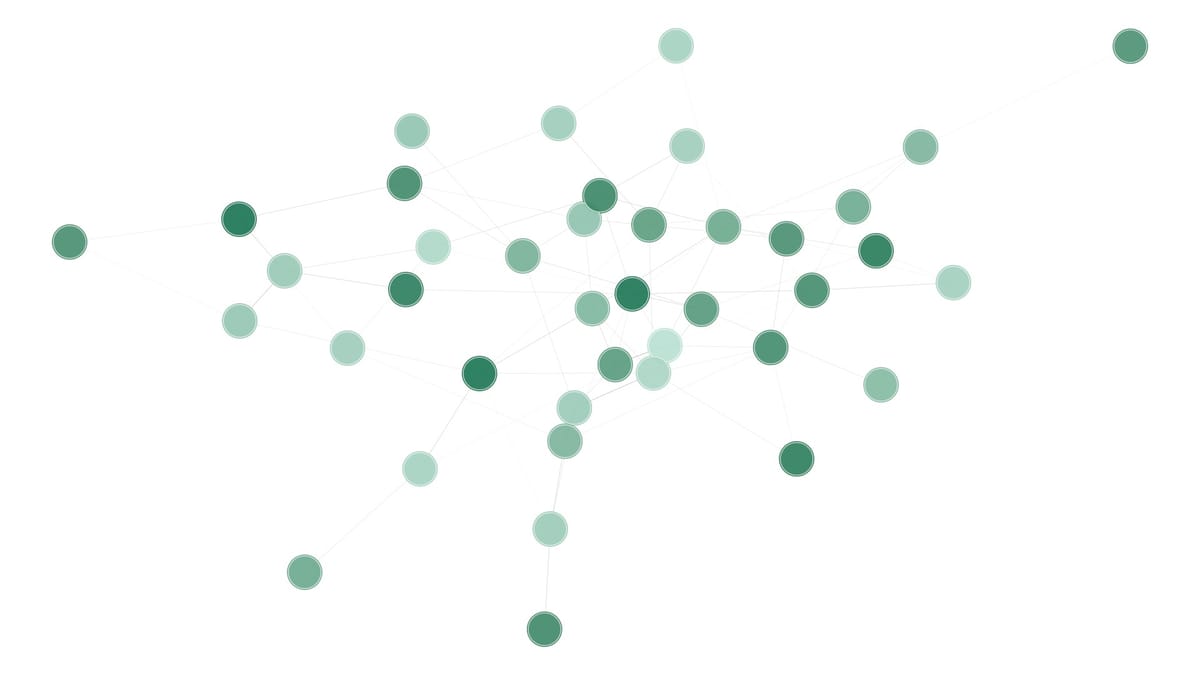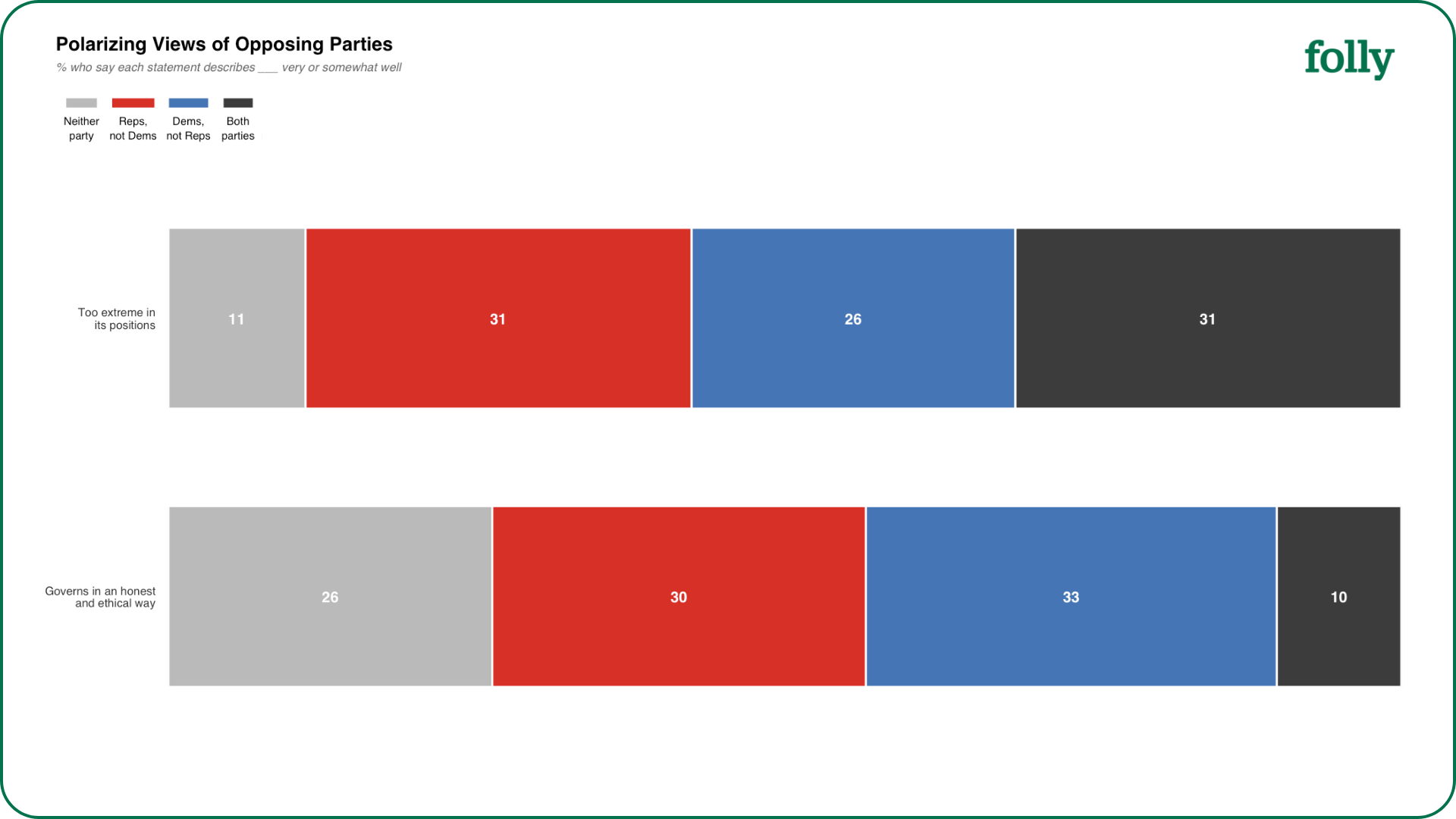Do Conservatives have more diverse attitudes on policy than Democrats?

Why are millions seeing a study allegedly saying this and why are many so quick to believe it?
Short answer: probably not, at least not to the extent being shared.
However, if you've been on social media recently, you may have seen a variation of a figure floating around that seems to insinuate that. Below is one such example: a network of nodes where the "blue" ones are tightly bound together while the "red" ones are much more spread out. This is typically followed by minimal context and a dramatized caption about how those on the left are close-minded and have a narrow set of extreme attitudes despite the openness they preach. This particular version was shared by conservative political commentator Tim Pool and viewed 2.1 million times.

While the figure is from a real study that talks about political attitudes and was published in the respectable British Journal of Social Psychology, the results are taken far out of context and directly contradict the conclusions the authors reached. However, to understand why this headline is misleading, it's first important to understand what the researchers actually did, what questions they asked, and how these nodes were calculated to begin with.
Breaking Down the Study:
The methodology behind the viral "attitude network" figure.
The study comes from the University of Hohenheim, where researchers sought to better understand how political affiliation shapes attitude structures. For this, they chose to focus on the two-party system of the United States. The study draws on two datasets: the first being 396 US crowd workers (paid online survey participants) who participated in testing by the researchers, and the second being a sensitivity analysis using 8,280 participants from the pre-existing 2020 ANES data.
We'll focus on the former, as that's where the data originated for the circulating figure. After self-reporting their partisan identification, each participant was asked a series of 8 questions with five answer choices on a Likert scale: strongly agree, somewhat agree, neutral, somewhat disagree, and strongly disagree.
Each question and potential response represents a node (8 questions × 5 response choices = 40 nodes). Now that we know where the nodes came from, what do their positions mean? Essentially, the researchers converted the forty potential responses into numerical form and fed them into an algorithm to determine the likelihood of one response predicting another.
That means the shorter the distance between any two given nodes, the more one view correlates with another. Thus, those further apart indicate that one opinion has less influence on, or is less related to, another.
Finally, based on the political affiliation of the participant who produced the response for each node, the color was assigned. Those with deeper blue indicate more Democratic responses, grey indicates independent, and deeper red indicates more conservative responses.
Issues With the Study:
While despite a sound premise there are issues with generalizability.
At this point, you may be thinking that after this explanation, the figure does indeed support the claim that conservatives have more diverse thought, in the sense that they have a wider array of less correlated opinions than liberals, as their nodes are much further apart. However, this conclusion isn't appropriate, as it ignores biases in the study design and methodological issues.
The largest issue at hand, which likely contributed to the Democratic nodes appearing overly clustered, is the questions asked. They are listed here:
- Abortion should be illegal
- The government should take steps to make incomes more equal.
- All unauthorized immigrants should be sent back to their home country
- The federal budget for welfare programs should be increased.
- Lesbian, gay, and trans couples should be allowed to legally marry.
- The government should regulate business to protect the environment.
- The federal government should make it more difficult to buy a gun.
- The federal government should make a concentrated effort to improve social and economic conditions for African Americans.
Now, if it wasn't already clear from reading these questions, most of these issues are ones that skew toward liberal homogeneity. For example, you would be hard-pressed to find someone on the left who doesn't support gay marriage, but you'd find a considerable number of conservatives who would would add various caveats to such a claim. The phrasing of these question promote unity on those who lean liberal but division on those who lean conservative. Naturally, the nodes would reflect this. A similar study could be performed asking questions about topics less agreeable with Democrats (but more unified among Republicans) such as views on capitalism, police funding, nuclear energy, and the node distribution would likely be flipped.
Another consideration is the initial sample composition, where 58.1% self-identified as Democrats, 28% as Independents, and 13.9% as Republicans. The researchers addressed this by re-weighting the data using Gallup Poll's party affiliation reporting (28% Democrat, 28% Republican, and 43% Independent), which should largely correct for this imbalance. However, with such a small initial pool of Republican participants (only 55 individuals), even after re-weighting, there's fewer underlying data to capture the full range of conservative viewpoints compared to the Democratic sample.
Note that these critiques are less a fault of the researchers, although there are potential study design issues they should have highlighted more prominently but are instead directed at those who use this study and the node figure to paint a specific narrative of extremism and close-mindedness in the Democratic party. Actors who share the figure in such a manner, are doing so in bad faith.
The correct and only way to interpret this figure is that for these eight very specific topics, Democrats tend to have a more united front and share opinions among themselves more than conservatives. It does not speak for the party populations as a whole and should not be used for that purpose.
Greater Implications:
Why discussing the results of this study and how the public perceive it matter.
Hundreds of thousands of conservative individuals saw this figure and believed it without question. That's the real issue here. Not just that the study was misinterpreted, but that so many people were eager to accept it as truth because it confirmed what they already believed about the other side.
This was highlighted in the study itself. The researchers performed additional testing that revealed significant in-group bias based solely on partisan identification. In-group bias meaning participants were significantly more likely to view someone negatively based purely on party affiliation. The very phenomenon that made this figure go viral is exactly what the researchers were documenting in their work.
This isn't isolated to the University of Hohenheim study. In fact, a poll by Pew Research Center found that among Americans surveyed, twenty-six percent found Democrats only to be too extreme in their policies, a third found Republicans only to be too extreme, and another third found both parties to be too extreme. Furthermore, a third believed only Democrats govern in an honest and ethical way, while another third believed that to be true only of conservatives. There is a growing and significant portion of each party that thinks the other is completely corrupted, extreme, and close-minded.

What I'm ultimately getting at is that this false narrative was latched onto so quickly by so many individuals because it's emblematic of very real issues. When people already hold these caricatured views of the opposing party, they're far more likely to accept misleading figures without question as the information simply confirms what they already believe. Although in this situation it was conservatives propagating this false narrative, it could have as easily been the opposite way around with some other headline.
While this figure may have been taken out of context, the underlying premise of political polarization and its effects on attitude structures is a very important and real topic. I don't have the answer for which party is more diverse in thought and has more heterogeneity in their belief systems, and for that matter, I don't think anyone can say with full certainty. I do suspect it's less a matter of political party and more contingent on the area of issue being discussed and what quartile of the political spectrum the individual belongs to.
The real issue I find is how eager individuals are, regardless of political affiliation, to put others in boxes and assume they share all the same opinions based solely on whether someone is Democratic or Conservative. These quick mental heuristics are not beneficial for political conversation or for how we view our fellow Americans.
It's becoming increasingly important to separate individuals from attitudes, because eventually there won't be room for political discussion if everyone is making assumptions about the entirety of another's belief system based on a single opinion they hold. This is not to say there aren't trends in what people believe, but as more and more individuals characterize those in opposing political parties as monoliths, we must be cognizant of the bias this carries and the potential for greater harm to discourse in this field. People are not a single opinion and far more than just their party affiliation. When we engage politically, we are best to keep that in mind.

